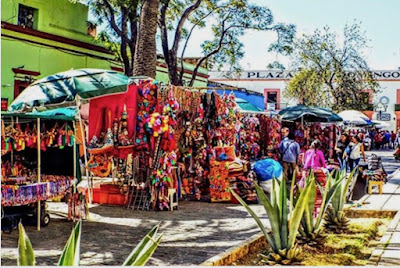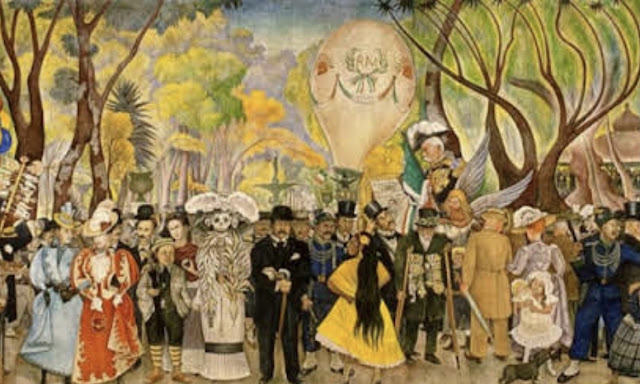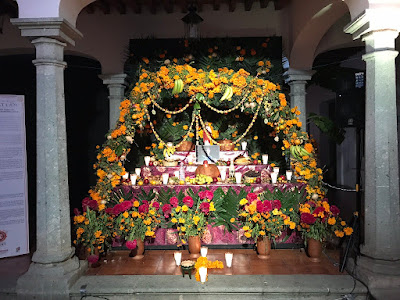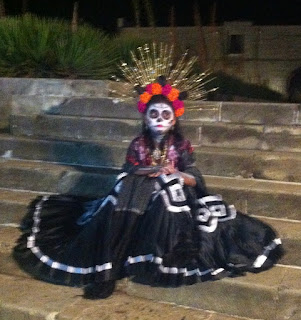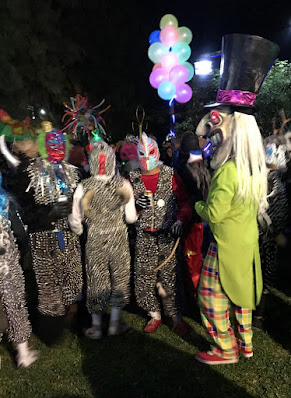
Celebrating Lives Past
Colourful costumes,
Daring disguises,
Magical music
And all its reprises ...
Honouring life,
Embracing death,
Living dreams
Til nothing left ...
“I cry to dream again”.
by rlbt
Day of the Dead (Dia de los Muertos) is rather a misnomer in Oaxaca, where festivities honouring the departed begin a good week in advance of this spiritual occasion.
There
is a convivial ambiance as Mexican folk go about their preparations. Friends and families come together at cemeteries to clean and decorate their
loved ones' gravestones and tombs. While others flock to specialist stores for costumes and accessories, as well as markets and bakeries for symbolic ornaments and delicacies.
Walking across town is often interrupted by carnival-style wedding
processions, complete with 'monos de calenda', giant puppets of the
bride and groom twirling in time to the music.
It is not just the centre of town where echos of the dead are present but also in the surrounding neighbourhoods, notably Barrio Xochimilco & Jalatlaco whose streets are a gauntlet of spooky surprises.

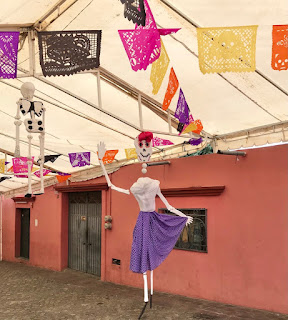


Despite the scary connotations, Mexican folklore honours and celebrates the dead, hence the omnipresence of 'calacas' (skulls and skeletons) throughout Mexico, particularly at this time of year. Creatively decorated skulls can be seen on tombs or shrines; and skeletons dressed as elegant ladies are also a common feature and reminiscent of Diego Rivera's Catarina in his 'Dream of a Sunday Afternoon in Almeda Park', thought to have instigated this tradition.
Another tradition is the ubiquitous 'offrendas', the shrines or altars that revere the departed and welcome their spirits back to the living world on the night of the Dia de los Muertos. Found in homes, on gravestones or as part of community display, shrines can be decorated with anything from modest candles, a favourite photograph or a few marigold 'flores de muerto', whose scattered petals guide the spirits. Festive foods are equal enticements, such as pan de muerto or sugar skulls; and even a favourite chocolate mole or shot of metzcal are offered to a past loved one! Brightly coloured 'papel picados' are often hung like paperchains. These delicate tissue-paper flags, with intricate lace-like designs, are to remind us of the beauty and fragility of life.

The festivities 'officially' begin on November 1st with All Saints' Day, when Mexicans believe that the souls of children (little angels, 'angelitos'), return to the living - so it is equally known as the Day of Little Angels (El Día de los Angelitos). These innocent angelitos are revered at gravesides and during Catholic masses.
Then, on 2nd November, Day of the Dead is dedicated to the adult spirits. This is when the principal celebrations take place, and is an opportune time for the living to jubilantly rejoice their ancestors by donning fascinating costumes, imaginative masks or painting faces, to be topped with fanciful headgear, be it floral or feathery. The cemeteries come 'alive' with families and friends gathered around graves to exchange special memories, while sharing favourite foods accompanied by shots of metzcal.
Dating back to the 1700s, 'La Muerteada' is a unique parade marking the Day of the Dead, which takes place in a small village of San Agustin Etla, just outside the city of Oaxaca. La Muertarda is punctuated by amateur dramatic plays performed by a local 'comparsa' - a troupe of budding thespians. This troupe was exclusively male until the local women formed 'La Muerteada de mujeres' in 1994. It is believed that the the dead equally take part in La Muerteada festivities, by occupying the living bodies of performers and spectators alike. Adorned with mirrors and bells weighing up to 90 kilos, the elaborate costumes are a significant part of this age old ceremony, demanding hours of assiduous toil in the days leading up to the opening night. La Muerteada begins on 1st November at 8 o'clock in the evening, when the parading troupe dance through the streets accompanied by musicians playing loud music. This is to the delight of reveling villagers, and thousands of visitors who flock to this relatively unknown village to witness this annual ritual. Whips are fiercely cracked as the troupe make their way to the designated locations for the satirical plays. These are performed by comical characters such as a happy widow with her ailing or deceased husband, an incompetent doctor, a corrupt politician and immoral priest, along with devils, personifications of death and many weeping women (las lloronas). The plays relate local gossip and tales of departed villagers, as well as political blunders and faux-pas of the past year. The festive parading and intermittent performances are repeated throughout the night, including various stops at welcoming homes providing local Oaxacan dishes accompanied by lots of mezcal and cervesas. This helps to keep the party going until dawn ... to start all over again on 2nd November!
